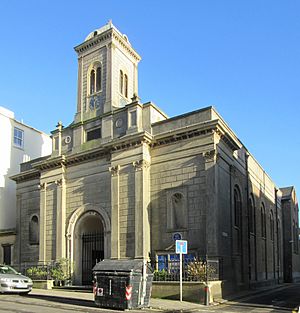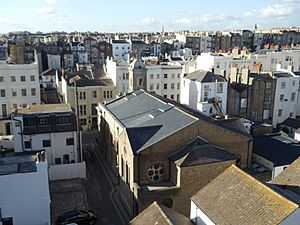St Andrew's Church, Waterloo Street, Hove facts for kids
Quick facts for kids St Andrew's Church |
|
|---|---|
| St Andrew's Church, Brunswick Town, Hove | |
 |
|
| Location | Waterloo Street, Hove, BN3 1AQ |
| Country | England |
| Denomination | Church of England |
| Website | www.visitchurches.org.uk |
| History | |
| Founded | 1827 |
| Founder(s) | Rev. Edward Everard |
| Dedicated | 5 July 1828 |
| Architecture | |
| Architect(s) | Sir Charles Barry |
| Style | Italianate |
| Years built | 1827–1828 |
| Closed | 14 February 1990 |
| Administration | |
| Diocese | Diocese of Chichester |
St Andrew's Church is a historic former church in the Brunswick Town area of Hove. Hove is part of the English city of Brighton and Hove. This church used to be part of the Anglican faith.
Today, the church is looked after by the Churches Conservation Trust. This is a special charity that helps protect old and important churches. St Andrew's Church was closed in 1990. However, in the 1800s, it was a very popular place for people to worship. It was built for the rich families living in the Brunswick estate. The building is so important that it is a Grade I listed building. This means it has "outstanding architectural or historic interest."
The Story of St Andrew's Church
Building a New Church in Brunswick Town
Before the 1820s, the land between Brighton and Hove was mostly farmland. Then, a new area called Brunswick Town was built. This happened because a similar project, Kemp Town in Brighton, was very successful. Brunswick Town was designed with fancy houses and buildings in the Regency style.
An architect named Charles Busby planned this new estate. Because of this and other new homes, Hove's population grew a lot. It went from only 100 people in 1801 to 2,500 people by 1841.
Why a New Church Was Needed
The only church nearby was St Andrew's, the old parish church. But it was quite far away and had become very run-down.
A church leader named Rev. Edward Everard owned land near Brunswick Town. He noticed that no church was planned for the new estate. So, he decided to build his own church on his land. This type of church was called a proprietary chapel.
Rev. Everard knew Charles Busby, but they had a disagreement earlier. So, Everard chose a different architect, Charles Barry. Charles Barry had already designed the Royal Sussex County Hospital and St Peter's Church, Brighton in Brighton. A special sign, called a blue plaque, is on the church to remember Barry.
Construction and Early Days
Building work on St Andrew's Church began in April 1827. Rev. Everard received a special law from Parliament in April 1828. This law gave him and future owners the right to own the church. It also allowed them to choose a church leader for 40 years. They would also get most of the money from people paying for their seats.
Rev. Everard himself became the first church leader. He served from the church's opening on July 5, 1828, until 1838.
A Popular Place of Worship
St Andrew's Church quickly became very popular with important and fashionable people. Members of the Royal Family and rich families often attended services. For example, Prince Adolphus, Duke of Cambridge, who was quite old, often made funny comments during services.
In 1851, a survey showed that 300 to 350 people regularly attended the church. There were 420 seats, and people paid to use 340 of them.
Changes and Updates to the Church
The inside of the church was changed in 1869. New open benches were put in, replacing the individual seats. A bigger change happened in 1882. The church was made larger at a cost of £7,000. Charles Barry's son, Edward Middleton Barry, added a new section called a chancel. He also added a special area with columns and a lit dome for an organ. The organ is gone now, but its case is still there.
More additions were made in the 1920s. These included a new pulpit and changes to the altar area. New stained glass windows were added, along with clear Venetian glass. These changes cost £4,000. The goal was to make the church brighter. They wanted to "create a little piece of Italy" inside the Italianate building.
Closing and Reopening
The church was used until the late 20th century. However, fewer people were attending services. So, it was officially closed on February 14, 1990. The church leaders thought about tearing it down. But because it was given Grade I-listed status in 1950, it could not be demolished.
The Churches Conservation Trust now owns and takes care of the building. In the 1990s, some damage occurred. But after a big restoration project in 2001 and 2002, costing over £100,000, the church reopened. It is now used for occasional services, special events, and community activities.
The church was always a "chapel of ease." This means it was built to help the main parish church, St Andrew's in Church Road. Since September 22, 2013, the church has also been used monthly by a group called The Sunday Assembly.
The Look of St Andrew's Church
Outside the Church
The outside of St Andrew's Church, facing west, was the first church in England to use the Italianate style. This style makes it look a bit like buildings you might see in Italy. The outside is made of brick and smooth stone.
The main entrance has a rounded arch. It is framed by twin columns. There is a small bell tower with a dome and clock faces. The bell inside was made in 1930.
Inside the Church
When it was first built, the inside was simpler. It was like a plain, box-shaped room for preaching. Now, the inside has a gallery at the west end. It also has a main area called a nave, and side sections called transepts. There is a chancel, a small chapel, and a room for the church leaders. The inside has special lighting from above and domes, giving it an Italian feel.
The entrance area, called the narthex, has a stone staircase leading to the gallery. Many memorial stones, which remember people, were moved here. However, five important memorials are still in the main nave. These include memorials for Lord Charles Somerset and Sir George Dallas, 1st Baronet.
Burial Vaults
St Andrew's is the only church in Hove with burial vaults underneath it. At the time the church was built, it was hard to find space for burials in Brunswick Town. This was because so many homes were being built.
Lord Charles Somerset, a politician who later became a governor in South Africa, was the first person buried in the vault in 1831. In 1854, a court order stopped any more burials. During World War II, the vaults were used as air-raid shelters to protect people.
See also
- Grade I listed buildings in Brighton and Hove
- List of churches preserved by the Churches Conservation Trust in Southeast England
- List of places of worship in Brighton and Hove


